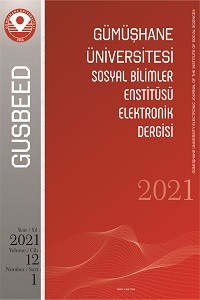Kuzey Kafkasya Bölgesinde Selefi Hareketler: 20. yüzyılın Sonu ve 21. Yüzyılın Başında Çeçenya ve Dağıstan
Öz
1979 yılında SSCB’nin Afganistan’a askeri müdahalesiyle birlikte radikal İslamcılık Doğu Asya ve Ortadoğu’yu etkileyen en önemli siyasal akım olarak ortaya çıkmıştır. Sovyetler Birliği’nin dağılması ile birlikte Afganistan ve Pakistan’da Sovyetlere karşı askeri eğitim alan ve mücadele veren mücahitler yeni hedeflere doğru yönelmiş veya yönlendirilmişlerdir. Mücahitler genel olarak Selefi-Vahabi inancına uygun olarak eğitilmişlerdir. Bunlar kimi zaman barışçıl ve siyasetten uzak kimi zaman da siyasi ve silahlı örgüt üyesi olarak faaliyet göstermektedirler. Bu faaliyet alanları genel olarak SSCB’nin ortadan kalması ve devlet otoritesinin zayıflamasının sonucu güç boşluğunun meydana geldiği bölgelerde yoğunlaşmaktadır. İŞID, El Kaide ve benzer Selefi örgütlerin Kafkasya bölgesine sızma girişimlerine sıklıkla rastlanmaktadır. Örgütlerin bünyelerinde, bu coğrafyadan gelen birçok teröristi barındırdığı ve dışsal yardımlar aldığı gerçeği göz önünde bulundurulmalıdır.
Bu makalede aşırı dinci grupların tarihsel süreçte Kuzey Kafkasya bölgesine yerleşmeleri ve faaliyeleri analiz edilecektir. Sonrasında ise bu grupların Çeçenistan ve Dağıstan Özerk Cumhuriyetlerine nüfuz etme çabaları incelenecektir.
Anahtar Kelimeler
Kaynakça
- Bobrovnikov, V. (2011). ’Ordinary Wahhabism’ versus ‘Ordinary Sufism’? Filming Islam for Postsoviet Muslim Young People, in: Journal Religion, State and Society, 39:2-3, 281-301.
- Forsyth J. (2013). Kafkasya (The Caucausu), Timuçin Binder (çev) Ayrıntı yay. İstanbul.
- Souleimanov, E. & Aliyev, H. (2014). The Individual Disengagement of Avengers, Nationalists, and Jihadists: WhyEx-Militants Chooseto Abandon Violence in the North Caucasus, Palgrave Macmillan, London.
Fundamentalist movements in the northern region of the Caucasus. Chechnya and Dagestan at the end of the 20th century and the beginning of the 21st century
Öz
The Mujahedeen, who had received military training in Afghanistan and Pakistan against Soviets and fought against that force, steered to new objectives or they were directed to do so after the dissolution of the USSR. The Mujahedeen received training in accordance with the Salafist-Wahabi faith in general. They sometimes operate peacefully in an impolitic manner but they also operate politically and act as a member of an armed organization at times. Their aforementioned field of activity is focused on regions, where a power vacuum occurred as the result of the dissolution of the USSR and the subsequent decline in the state authority. The attempts of Selefi organizations such as ISIS and Al-Qaeda to infiltrate into the Caucasian region are common. It should be noted that the indicated organizations house a large number of terrorists from this region within their own structure and that they also receive external aid and assistance.
In this article, the actions of the fundamentalist groups to settle into the Northern Caucasian Region and their activities shall be analyzed within the historical context. Afterwards, the attempts of the aforementioned groups to infiltrate into Chechnya and Dagestan Autonomous Republic shall be examined.
Anahtar Kelimeler
Kaynakça
- Bobrovnikov, V. (2011). ’Ordinary Wahhabism’ versus ‘Ordinary Sufism’? Filming Islam for Postsoviet Muslim Young People, in: Journal Religion, State and Society, 39:2-3, 281-301.
- Forsyth J. (2013). Kafkasya (The Caucausu), Timuçin Binder (çev) Ayrıntı yay. İstanbul.
- Souleimanov, E. & Aliyev, H. (2014). The Individual Disengagement of Avengers, Nationalists, and Jihadists: WhyEx-Militants Chooseto Abandon Violence in the North Caucasus, Palgrave Macmillan, London.
Ayrıntılar
| Birincil Dil | İngilizce |
|---|---|
| Bölüm | Makaleler |
| Yazarlar | |
| Yayımlanma Tarihi | 23 Şubat 2021 |
| Gönderilme Tarihi | 26 Kasım 2020 |
| Yayımlandığı Sayı | Yıl 2021 Cilt: 12 Sayı: 1 |



